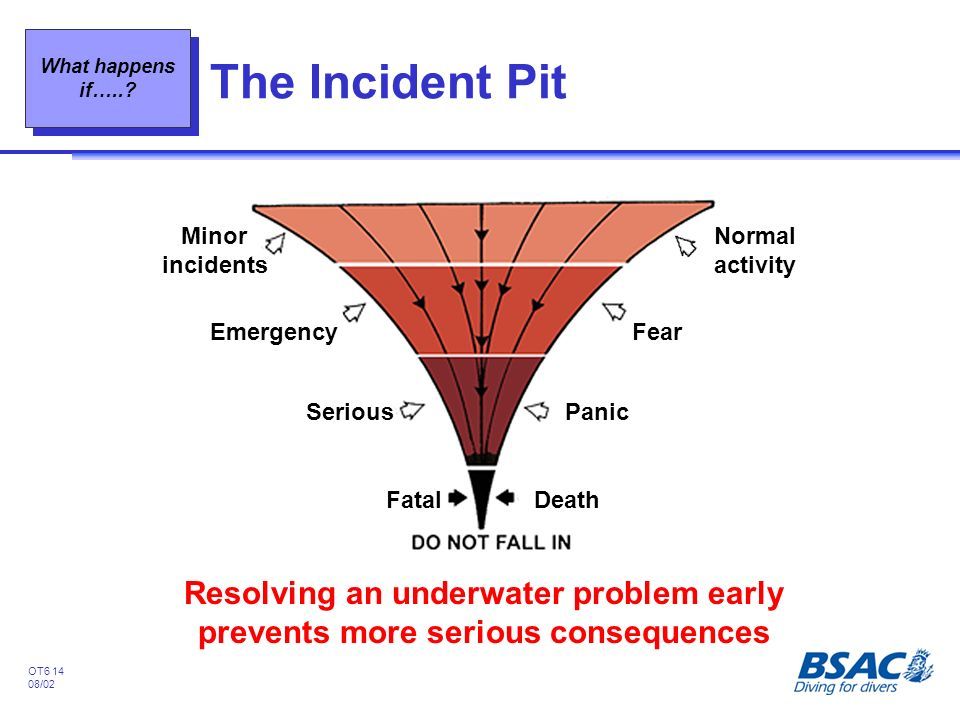
By Jon Kieren
You are 100 m (330 feet) below the surface.
You hear a massive cloud of bubbles behind your head. This can be resolved in two ways.
- One way is to start by reporting to your teammate and maintaining your position in the water column (stay stabilized). You pass your hands behind your head and close what you think is the affected tap. With your teammate, you identify and isolate the failure. You clearly communicate the problem within the team. Everyone knows what resources have been affected (gas supply, Wing, the inflative of the waterproof combination, etc.). Diving ends and you are starting to go up.
- The other way? It's when things don't go as planned.
When nothing goes as planned
When the incident occurs, your stabilization is disturbed.
- While you reach the fleeing tap to close it, you lose sight of your team. In doing so, you lose your reference points for your stabilization.
- While you strive to close your tap, stress rises. CO2 is starting to settle in your blood system as your heart and respiratory frequencies increase.
- A "tunnel" vision can settle, your stabilization is starting to change due to the modification of your ventilation. Because of your disorderly and unconscious palm, you start to go up. You are so focused on closing the tap that you do not realize that you are going up.
- When you achieve your ascent, stress increases and panic can settle. You are no longer able to manage the situation rationally.
- Instead of rectifying your stabilization and managing your ascent, you continue to try to close the tap. Your rise becomes fast and uncontrollable.
When you reach the surface, you are dead.
This situation can occur in a wide variety of circumstances. Small errors and failures can quickly evolve towards an emergency. This is valid that you are on a wreck, in deep waters, at the bottom of a cave or even in a short bottom.
When we look at accidents and incidents in diving, equipment failure is almost never the final cause of a fatal incident. Such failures are often the succession of chain errors which precipitate an uncomfortable situation in a fatal situation.
We often categorize these accidents as human errors. We think, "It was stupid. This is not how I should have reacted. I should have been able to control my stabilization. I am great "

The concept of "incident abyss"
At the 1973 "British Sub Aqua Club British Club Club" Sub Aqua Club, Johntowse concept of the "incident gulf". This concept explains that when a problem occurs and it is not managed properly, it becomes more and more difficult to manage.
We slide more deep into the abyss, unable to get out of the way or extract the teammates from this situation and it becomes potentially fatal. This concept is easy to visualize but many of us tend to forget where the real failure resides: stabilization.
When a dive takes place, we play at the first level of the incident chasm. We manage normal situations such as communication, stabilization changes, orientation choices, etc. with relatively ease.
But what we do little is that with great attention paid to the management of stabilization and balance, our ability to deal with complex tasks such as material problems is more limited. We get out of the wreckage or the rise line because of the current, or we make an uncontrolled rise. A minor problem can create an emergency situation.
How to solve a problem in extreme environment?
Start with a solid basis of fundamentals. Train until the basics are mastered such as the Valve Drills (closure of the taps, handling the manifold tap) and S-Dills (Safety Drills: Giving air or receiving it whatever the situation), all with the maintenance of its position. You have to be able to react without swimming (swallowing movement with the hand), palmer or concentrate in an unsuitable manner on its stabilization and its trim (balance, flat).
Breathe gas mixtures with low end (equivalent Narcotic Depth: depth equivalent to the air) and low density (good adequacy of the trimix mixture with the maximum depth).
In doing so, you will be able to focus on the problem that presents itself to you. You will be able to assess the situation, to analyze which resources are available (on you or your teammate) and to carry out the decisive action that will resolve the situation.
Most of the time, nothing will happen to you. However, the problems occur when you dive, it is the nature of this sport. Do not emphasize the work of fundamentals is to prepare for failure when confrontation with these situations.
It is your responsibility as a diver and teammate to maintain the acquisition of these skills.


Let a comment